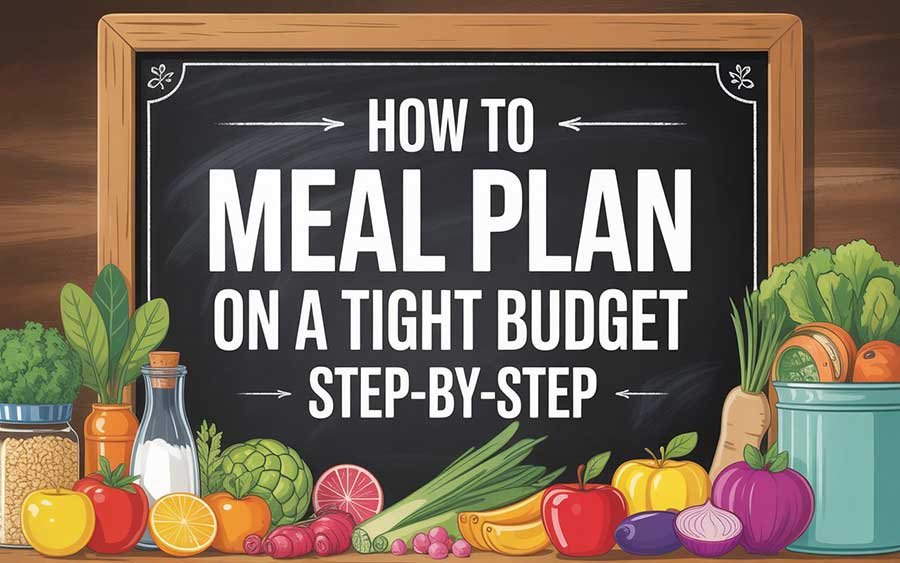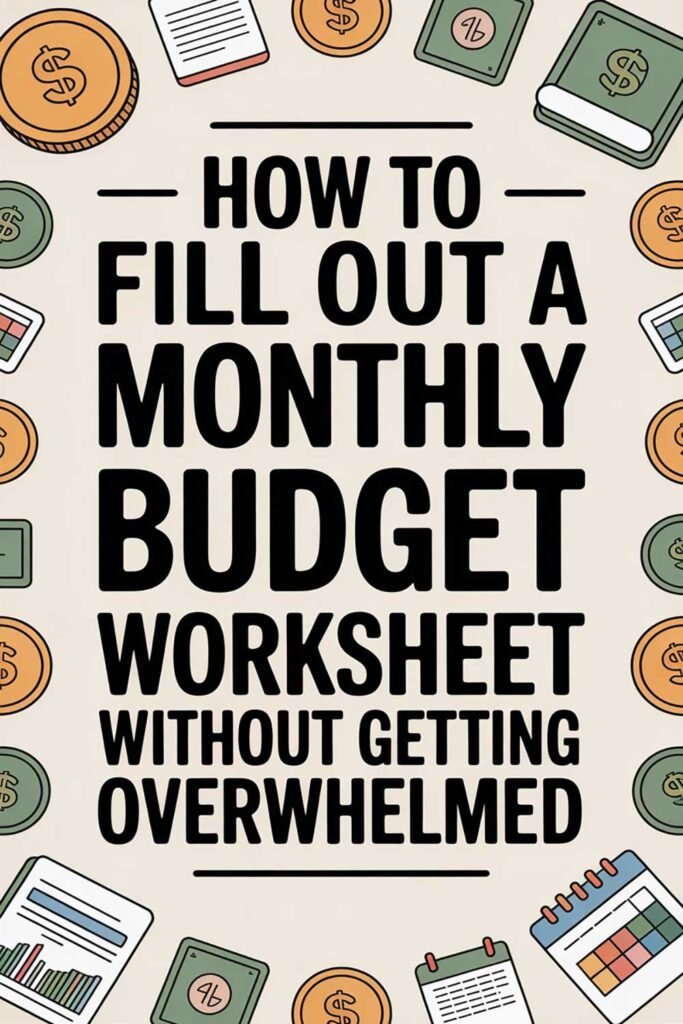
How to Meal Plan on a Tight Budget: Your Step-by-Step Guide to Saving Big on Groceries (Without Sacrificing Flavor!)
Do you ever stare into your refrigerator, hoping for inspiration, only to be met with a few random ingredients and a nagging sense of dread about dinner? Or perhaps you find yourself resorting to expensive takeout or last-minute impulse buys because you just don’t have a plan? In today’s economic climate, where grocery prices seem to be perpetually on the rise, feeding yourself or your family nutritious and delicious meals on a tight budget can feel like an insurmountable challenge. The stress of managing food costs often leads to frustration, food waste, and a feeling that you’re constantly fighting an uphill battle.
I know that feeling all too well. For years, my grocery budget was a runaway train. I’d buy ingredients for one or two specific meals, only to have half the produce go bad or spices sit untouched. Impulse buys at the checkout added up, and the convenience of a quick, expensive meal delivery often won over the effort of cooking. My food spending was a significant drain on my finances, and honestly, a source of constant low-level anxiety.
Then, I discovered the transformative power of strategic meal planning – not just meal planning, but meal planning on a tight budget. This wasn’t about eating boring, bland food or sacrificing nutrition. It was about becoming incredibly intentional with every dollar, leveraging sales, minimizing waste, and unleashing a surprising amount of culinary creativity. The result? A drastic reduction in my grocery bill, less food waste, more delicious home-cooked meals, and a significant boost in my financial confidence.
This comprehensive, step-by-step guide is designed to empower you to take control of your food budget, transforming overwhelm into efficiency and frustration into culinary triumph. We’ll walk through a proven process that makes budget meal planning simple, sustainable, and surprisingly satisfying. Get ready to turn your kitchen into a hub of savings and deliciousness!
Why Mastering Budget Meal Planning is Your New Financial Superpower
Beyond simply cutting costs, effective budget meal planning offers a wealth of benefits:
- Significant Savings: This is the most obvious, and often the most compelling, reason. You’ll be amazed at how much you can save when you plan intentionally. For a deeper dive into overall grocery budgeting, check out The Ultimate Guide to Grocery Budgeting for Beginners.
- Reduced Food Waste: When every ingredient has a purpose, you’ll throw away far less spoiled produce and forgotten leftovers, which is like finding free money.
- Healthier Eating: Planning meals means more cooking from scratch, using fresh ingredients, and avoiding expensive, processed convenience foods.
- Less Stress & Decision Fatigue: The “what’s for dinner?” dilemma disappears, freeing up mental energy for other areas of your life. This aligns perfectly with principles found in My 3-Step Daily Planning Routine.
- More Organized Kitchen: With a plan, your fridge and pantry become more organized, making cooking easier and more enjoyable.
- Time Savings: While it takes a little time upfront, meal planning saves you countless hours during the week by reducing trips to the store and last-minute cooking scrambles.
This isn’t about deprivation; it’s about smart resourcefulness and making your food budget work for you. For more context, you can also explore how to approach How to Meal Plan on a Tight Budget through a broader lens.
Your Step-by-Step Blueprint for Meal Planning on a Budget
Ready to transform your grocery spending and kitchen habits? Grab a notebook, a pen, or open a digital planning tool. We’re going to create your budget-friendly meal plan!
Step 1: Set Your Monthly Food Budget (Be Realistic & Honest)
Before you buy anything, you need to know your limit.
- Review Past Spending: Look at your bank statements or credit card bills from the last 1-3 months. How much are you currently spending on groceries, takeout, and restaurant meals?
- Set a Target: Based on your current spending and your financial goals, decide on a realistic but challenging monthly budget. For example, many families of four aim for $400-$600, but adjust this based on your location and family’s needs.
- Break it Down Weekly: Divide your monthly budget by 4 or 4.33 (for weeks in a month) to get a weekly spending target. This makes it more manageable.
Real-Life Example: The Chen family realized they were spending $900-$1,000 a month on food, including a lot of takeout. They decided to challenge themselves to reduce it to $600. This meant aiming for $150 a week. This clear target motivated them for the steps ahead, a mindset shift central to challenges like The Ultimate Save Money, Live Better Challenge: 30-Day Plan.
Step 2: Audit Your Kitchen & Check Sales Flyers (The Intelligence Gathering)
This step saves you money before you even think about recipes.
- Pantry, Fridge, Freezer Inventory: Take stock of everything you already have. What dry goods (pasta, rice, beans, canned goods, spices) are on hand? What produce needs to be used soon? What meats or vegetables are in your freezer? Make a list.
- Check Weekly Sales Flyers: Get the digital or physical flyers from your preferred grocery stores. Focus on sales for:
- Proteins: Meat, poultry, fish, tofu, beans, eggs. These are often the most expensive items.
- Produce: Seasonal fruits and vegetables are usually cheaper.
- Pantry Staples: Canned goods, pasta, rice, flour, oats.
- Combine Information: Now you know what you have and what’s cheap. This is your foundation.
Real-Life Example: Maria, a single mom of two, used to just buy what she needed for recipes. Now, every Saturday morning, she makes a list of her pantry contents and then checks three local grocery store apps for their weekly sales. She noticed ground turkey was on sale for a fantastic price at one store and a huge bag of potatoes was cheap at another. This immediately started shaping her meal ideas.
Step 3: Brainstorm Meals Based on Inventory & Sales (The Creative Hub)
This is where you marry your existing ingredients with current sales.
- Start with “Use It Up” Meals: Prioritize meals that use ingredients you already have and need to consume. That wilting broccoli? Make a frittata. Those extra canned tomatoes? Pasta sauce.
- Build Around Sales: If chicken thighs are on sale, plan 2-3 meals around chicken (e.g., roasted chicken, chicken tacos, chicken stir-fry). If beans are cheap, think chili, burritos, or a hearty bean soup.
- Focus on Cheap Staples: Incorporate budget-friendly basics like rice, pasta, potatoes, oats, eggs, and lentils. These stretch meals further.
- Repurpose Ingredients: Think about how one ingredient can serve multiple meals. Cook a large batch of rice to use in a stir-fry one night and as a side dish another. Roast a whole chicken and use the leftovers for sandwiches or soup.
- Don’t Forget Breakfast & Lunch: These are often overlooked but can be major budgetbusters. Plan for simple, repeatable options like oatmeal, eggs, sandwiches, or soup.
- Consider Meatless Meals: Incorporate 1-2 vegetarian meals a week using inexpensive proteins like beans, lentils, chickpeas, or eggs.
Real-Life Example: Given her ground turkey and potato sales finds, Maria planned: Monday: Turkey & Potato Hash, Tuesday: Turkey Tacos (using leftover turkey), Wednesday: Baked Potatoes with chili (using canned beans she had). This way, the ground turkey stretched for two dinners, and the potatoes for two, maximizing her purchase.
Step 4: Write Your Meal Plan (Your Weekly Roadmap)
Now, put it all down on paper.
- List Each Day & Meal: Create a simple grid or list for breakfast, lunch, and dinner for 7 days.
- Be Specific (but flexible): Write down the main dish. For example, “Chicken Stir-fry with rice,” not just “Chicken.”
- Include Snacks: Assign budget-friendly snacks like fruit, yogurt, nuts, or popcorn.
- Plan for Leftovers: Intentionally schedule “leftover night” or use dinner leftovers for lunch the next day. This is key to zero-waste budgeting.
Tip: Don’t aim for gourmet meals every night. Simple, wholesome, and repeatable is the goal for budget meal planning.
Step 5: Create Your Precise Grocery List (Stick to It!)
This is where your plan becomes actionable.
- Only List What You NEED: Go through your meal plan day by day and list only the ingredients you don’t already have in your inventory.
- Be Specific with Quantities: Don’t just write “apples”; write “4 apples.” This helps prevent overbuying.
- Organize by Store Layout: If you know your grocery store well, organize your list by sections (produce, dairy, pantry, frozen) to save time and prevent impulse buys.
- NO Impulse Buys: This is a golden rule. If it’s not on the list, it doesn’t go in the cart. This requires discipline.
Real-Life Example: The Chen family found themselves constantly exceeding their budget by picking up “just one more thing.” After creating their precise list, they started making a game of it: if it wasn’t on the list, it didn’t enter the cart. Their kids even got involved, pointing out if Mom or Dad was about to grab something unplanned. This simple discipline made a huge difference to their weekly spend.
Step 6: Go Shopping (Armed and Ready!)
Execute your plan.
- Stick to Your List: Seriously, do not deviate. This is where your planning pays off.
- Check Unit Prices: Compare prices of different brands or sizes to find the best value (e.g., price per ounce/gram). Bulk is often cheaper, but not always!
- Use Coupons/Loyalty Programs: Apply any relevant digital or paper coupons.
- Avoid Shopping Hungry: This is the easiest way to make impulse buys. Eat before you go!
- Consider Discount Grocers: Stores like Aldi, Lidl, or local ethnic markets often offer significantly lower prices on staples and produce.
Step 7: Prep & Cook (Maximize Your Efficiency)
Your work isn’t done after shopping!
- Designate a Prep Time: Spend an hour or two after shopping (or on a weekend) washing and chopping produce, portioning meat, and pre-cooking grains. This makes weeknight cooking much faster and reduces the likelihood of resorting to takeout.
- Batch Cook: Cook large quantities of staples like rice, quinoa, or roasted vegetables to use in multiple meals throughout the week. Make a double batch of soup or chili and freeze half.
- Utilize Leftovers: Don’t let anything go to waste. Pack leftovers for lunch, or repurpose them into new meals.
- Creative Leftover Transformation: Leftover roasted chicken can become chicken salad. Leftover rice can become fried rice. Get creative!
Real-Life Example: Jessica used to dread cooking after a long workday, often leading to ordering food. Now, every Sunday, she dedicates two hours to “prep central.” She chops all her veggies for the week’s stir-fries, makes a big batch of quinoa, and pre-cooks some chicken breasts. “Coming home on a Tuesday and just having to throw pre-chopped veggies into a pan with some sauce feels like a superpower,” she says. “It removes the barrier to cooking and makes it so much easier to stick to my budget.”
The Mindset Shift: From Overwhelm to Empowerment
Meal planning on a budget isn’t just about spreadsheets and grocery lists; it’s about a fundamental shift in your relationship with food and money. It moves you from a reactive state to a proactive one, empowering you to make conscious choices that serve your financial goals and your health. It might take a few weeks to get into the groove, but the consistency will pay off immensely.
Picture This…
Imagine your week. No more frantic mid-week grocery runs. No more staring blankly into the fridge, wondering what to make. Your meal plan is clearly laid out, your grocery list is concise, and your pantry is organized. You come home after a long day, and dinner comes together effortlessly because you’ve prepped ingredients or have a delicious, budget-friendly meal ready to go. You see your grocery bill shrink, your food waste dwindle, and your financial savings grow. The satisfaction of nourishing your family with delicious, home-cooked meals, all while sticking to your budget, brings a profound sense of peace and accomplishment. This isn’t just a budget hack; it’s a lifestyle upgrade that brings order, savings, and joy to your kitchen.
20 Powerful Quotes on Meal Planning & Frugal Living
- “A goal without a plan is just a wish.” – Antoine de Saint-Exupéry
- “Waste not, want not.” – Proverb
- “By failing to prepare, you are preparing to fail.” – Benjamin Franklin
- “Cook from scratch. It is cheaper, healthier, and usually more fun.” – Unknown
- “The way to save money is to get out of your head that you have to spend it.” – Catherine Zeta-Jones
- “Frugality is founded on the most generous of instincts, and is the happy medium between avarice and profusion.” – Charles Caleb Colton
- “Food is our common ground, a universal experience.” – James Beard
- “It’s not how much money you make, but how much money you keep.” – Robert Kiyosaki
- “The best things in life are free. The second best are very expensive.” – Coco Chanel (Focus on the ‘free’ aspect of smart planning!)
- “Good food is the foundation of genuine happiness.” – Auguste Escoffier
- “Eat to live, not live to eat.” – Socrates
- “A budget is telling your money where to go instead of wondering where it went.” – Dave Ramsey
- “The only man who sticks closer to you than your shadow is your creditor.” – Proverb (Meal planning helps avoid debt!)
- “You don’t have to cook fancy or complicated masterpieces – just good food from fresh ingredients.” – Julia Child
- “Successful people are simply those with successful habits.” – Brian Tracy
- “Plan your work and work your plan.” – Napoleon Hill
- “The greatest wealth is health.” – Virgil (Eating well on a budget supports this.)
- “Being frugal is not about cutting out all the things you love. It is about cutting out the things you don’t love so you can afford the things you do.” – Melissa Blevins
- “Frugality is enjoying the things you have.” – Unknown
- “If you fail to plan, you are planning to fail!” – Winston Churchill
Disclaimer
Please note: This article is for informational purposes only and is based on general principles of meal planning and budget management. While the strategies outlined have been successfully implemented by many individuals and families, individual results may vary significantly based on local grocery prices, dietary needs, family size, and personal discipline. This content is not a substitute for professional dietary advice or financial counseling. Always consider your unique circumstances.
Share This Article!
Are you ready to revolutionize your grocery budget and bring more order to your kitchen? If this step-by-step guide has inspired you, please share it with friends, family, or on your social media! Let’s empower more people to eat well and save big.






